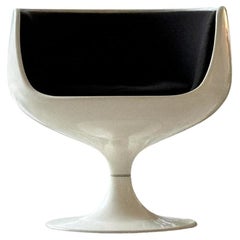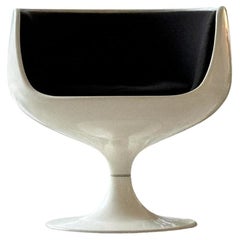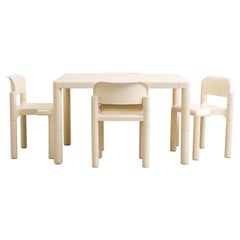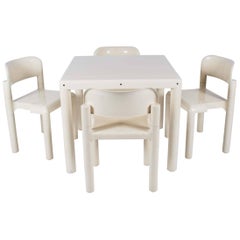Eero Aarnio Dining Room Sets
“I always look ahead, never back,” Finnish design legend Eero Aarnio has been quoted as saying. A leading innovator of modern furniture design, Aarnio has long embraced a bold, playful, confident and colorful style several steps ahead of his time.
For his 1954 entrance test for the Institute of Industrial Arts in Helsinki, Aarnio created a whimsical painting of a man reading a newspaper in a red, curved chair whose silhouette foreshadowed Aarnio’s Ball chair of 1963. That spherical seat skyrocketed him to design fame, and decades later, it is still recognized as one of the world’s most futuristic designs.
Born in 1932 to a house painter and a seamstress, Aarnio has always had a cheerful disposition and an independent spirit. He went his own way early on: After just two years at Asko, the big Scandinavian furniture company that originally produced his Ball chair, Aarnio established his own studio in 1962.
Over the next decade, the young visionary made an indelible mark on the world. Open-minded and entrepreneurial, Aarnio embraced the aesthetics, materials and technologies of the Swinging Sixties, working with a new generation of plastics and molding them into fluid, organically shaped, brightly hued forms.
Introduced at the 1966 Cologne Furniture Fair, the pod-like fiberglass Ball chair soon adorned the homes of movie stars and royalty, graced magazine covers around the world and was featured in films and ads. The groundbreaking seat originally came in orange, white, black, yellow and red and could be ordered with a telephone installed in it. Yet this designer of the future, as he was known in the 1960s, has always insisted that he didn’t deliberately seek to be associated with the decade’s sci-fi aesthetic.
“I had no intention to create either pop or Space Age design — as many people label my work,” Aarnio declares in one of the essays included in Eero Aarnio — Designer of Colour and Joy, a book jointly created by the Design Museum and publisher WSOY to accompany 2016’s “Eero Aarnio” exhibition.
The show featured a number of Aarnio’s objects, including his iconic Ball, Pastil (1967), Bubble (1968), Tomato (1971) and Pony (1973) chairs. These were joined by lesser-known seating and other objects like the rattan Juttujakkara, or mushroom, stool (1960); the sculptural Double Bubble lamp (2000), with which Aarnio first explored the possibilities of rotation-cast plastic; and the three-legged Rocket (1995) and Baby Rocket (2006) stools, both parts of a collection produced by Artek after Tom Dixon, the company’s creative director from 2004 to 2009, discovered the original piece in Aarnio’s kitchen.
“Aarnio expanded the whole idea of what constitutes furniture,” explained Suvi Saloniemi, the Design Museum’s chief curator. “His significance as a designer is crystallized in the liberation of form that he has introduced by discovering the properties of plastic as the material of a designer. His furniture is sculpture-like and eye-catching, but the pieces are always utilitarian at the same time.”
Find an extraordinary range of vintage Eero Aarnio chairs, tables and other furniture on 1stDibs.
Mid-20th Century Finnish Space Age Eero Aarnio Dining Room Sets
Fabric, Fiberglass
Mid-20th Century Finnish Space Age Eero Aarnio Dining Room Sets
Fabric, Fiberglass
2010s Finnish Modern Eero Aarnio Dining Room Sets
Fiberglass
2010s Finnish Modern Eero Aarnio Dining Room Sets
Maple
2010s European Post-Modern Eero Aarnio Dining Room Sets
Steel, Stainless Steel
2010s Finnish Eero Aarnio Dining Room Sets
Walnut
1960s Swedish Mid-Century Modern Vintage Eero Aarnio Dining Room Sets
Fabric, Glass, Wood
1970s Bulgarian Space Age Vintage Eero Aarnio Dining Room Sets
Chrome
Mid-20th Century Italian Space Age Eero Aarnio Dining Room Sets
Marble, Aluminum
1970s Finnish Space Age Vintage Eero Aarnio Dining Room Sets
Fiberglass, Lacquer
Mid-20th Century Finnish Mid-Century Modern Eero Aarnio Dining Room Sets
Wicker
1970s Finnish Mid-Century Modern Vintage Eero Aarnio Dining Room Sets
Metal
1960s American Mid-Century Modern Vintage Eero Aarnio Dining Room Sets
Aluminum
1970s European Mid-Century Modern Vintage Eero Aarnio Dining Room Sets
Aluminum
1970s Finnish Mid-Century Modern Vintage Eero Aarnio Dining Room Sets
Metal
1970s Finnish Mid-Century Modern Vintage Eero Aarnio Dining Room Sets
Plastic
1970s Finnish Mid-Century Modern Vintage Eero Aarnio Dining Room Sets
Plastic
1970s Finnish Mid-Century Modern Vintage Eero Aarnio Dining Room Sets
Plastic
Eero Aarnio dining room sets for sale on 1stDibs.
- 1stDibs ExpertFebruary 1, 2024Whether or not Eero Aarnio Ball chairs are comfortable or not is largely a matter of personal opinion. When the chair debuted in 1966, the New York Times reporter who saw it at the International Furniture Fair in Cologne suggested that the seating on display was "designed more for laughs than for comfort." However, the distinctive chair brought Aarnio instant commercial success. Today, many people still find the inviting foam-filled fabric seat inside its molded-fiberglass orb to be as comfortable to sit on as it is pleasing to the eye. Shop an assortment of vintage Eero Aarnio Ball chairs on 1stDibs.




